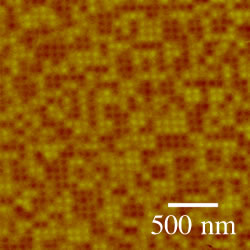![]()
Bit patterned media have attracted considerable interest as future high density magnetic recording media, since they provide a promising technology to postpone the problem of superparamagnetic limit, i.e., thermal instability of the recorded bits in the media. Major problems for the practical use of the bit patterned media are topography of discrete magnetic bits defined by lithographical fabrication which disturbs stable flying of the HDD head and switching field distribution which is considered to be due to the re-deposition of the etched materials. Ion beam irradiation has been proposed as a new approach to pattern magnetic materials locally without etching magnetic materials, and ion irradiation into Co/Pt and Co/Pd multilayers (MLs) has been reported for the local modification of their perpendicular anisotropies. However, in the Co/Pt and Co/Pd MLs patterned by ion irradiation, the adjacent magnetic bits are not magnetically isolated due to the exchange coupling through in-plane magnetized spacing, which will limit the ultimate density of the media. |
MFM image of CrPt3 bit patterned medium fabricated by ion irradiation method (bit size: 50 nm x 50 nm). |

